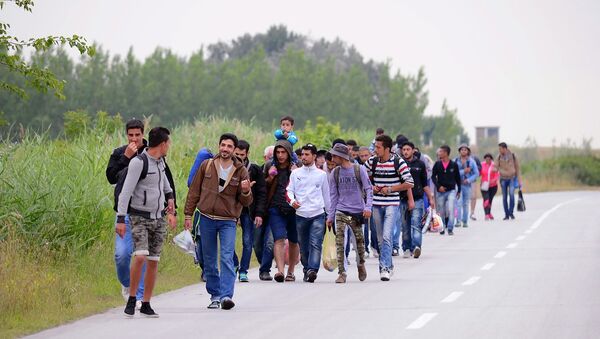The fence will be built in sections, with the first portions going up in areas used most heavily by human smugglers, which Hungarian authorities blame for the recent influx of migrants. These areas include the village of Asotthalom in the Southern Great Plain region of southern Hungary, where on Monday heavy machinery drove metal rods into the ground, initial steps in the construction of the nearly 4-meter (13-foot) wall.
Thousands of migrants and refugees are streaming into the EU via Hungary. Hungary's answer? Build a fence. https://t.co/BnFcrQRCfq
— AJ+ (@ajplus) July 31, 2015
The Hungarian government, which was shown a 150-meter sample of the fence some 2 weeks ago, has high hopes the fence will be completed, spanning the entire 175-kilometer (109-mile) border with Serbia, by the end of the summer.
In addition to soldiers and those in a state work program, Hungarian prisoners are taking part in the fence construction as well, preparing the razor wire that will be placed along the top of the barrier, the Associated Press reported.
Since the beginning of 2015, the number of asylum seekers using the western Balkans to reach Hungary has skyrocketed to more than 100,000, more than twice as many as in 2014 (around 43,000), and more than five times as many as in 2013 (18,900).
This is the fence Hungary is building on its border w Serbia in attempt to stop flow of refugees/migrants into Europe pic.twitter.com/wb7RmQBUcW
— Kristen Chick (@kristenchick) July 30, 2015
Prosecutors said Monday that law enforcement had detained five people, including three police officers, believed to be involved in migrant smuggling in the southern part of the country.
Over the past few months, according to AP, around 80 percent of migrants entering Hungary have come from conflict zones like Syria, Iraq and Afghanistan, compared to earlier statistics that showed the majority of them arriving from Kosovo.
Most migrants apply for asylum in Hungary, but attempt to move to European Union countries further west, where social benefits are believed to be the most generous in Europe.
'If u come to #Hungary ':a different story about #refugees traveling through the #Balkans http://t.co/6rjt8YezgX pic.twitter.com/dQSTM5i9n1
— S.O.S. Europe (@SOS_Europe) August 1, 2015
Ahmed Saad, a refugee from the Kurdish community in Iraq, traveled to Asotthalom with a group that walked across Turkey and Bulgaria to reach the EU.
"We left all — my job, all my car, my house, all things, because we ran going to Germany," said Saad shortly after crossing into Hungary.
Hungary has recently amended legislation on the classification of asylum seekers. The country now regards Serbia, Macedonia, Bulgaria and Greece as "safe" countries. Any asylum seeker crossing the country's border from a "safe" country will be classed as an "economic migrant," which allows authorities to more expediently return them to their place of origin.



